 W
WThe African Queen is a 1935 novel written by English author C. S. Forester. It was adapted into the 1951 film of the same name.
 W
WAllan and the Ice-Gods is a novel by H. Rider Haggard featuring his recurring character Allan Quatermain, based on an idea given to Haggard by Rudyard Kipling. The story details Quatermain's past life regression to a Stone Age ancestor and the various adventures involved.
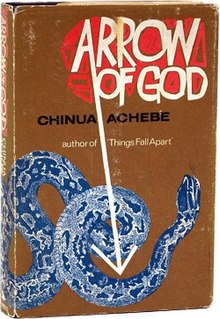 W
WArrow of God, published in 1964, is the third novel by Chinua Achebe. Along with Things Fall Apart and No Longer at Ease, it is considered part of The African Trilogy, sharing similar settings and themes. The novel centers on Ezeulu, the chief priest of several Igbo villages in colonial Nigeria, who confronts colonial powers and Christian missionaries in the 1920s. The novel was published as part of the influential Heinemann African Writers Series.
 W
WCarcase for Hounds is a novel by Kenyan writer Meja Mwangi first published in 1974. The novel concerns the Mau Mau liberation struggle during the latter days of British colonial rule and attempts, by the actions of the main protagonists, to show how Mau Mau was organized and why it took so long for the colonial government to defeat them. Carcase for Hounds received mixed reviews. The novel was also adapted into a movie by Ola Balogun, Cry Freedom.
 W
WChild of Storm is a 1913 novel by H. Rider Haggard featuring Allan Quatermain. The plot is set in 1854-56 and concerns Quatermain hunting in Zululand and getting involved with Mameema, a beautiful African girl who causes great turmoil in the Zulu kingdom.
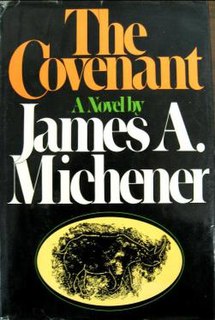 W
WThe Covenant is a historical novel by American author James A. Michener, published in 1980. The novel is set in South Africa, home to five distinct populations: Bantu, Coloured, British, Afrikaner, and Indian, Chinese, and other foreign workers. The novel traces the history, interaction, and conflicts between these populations, from prehistoric times up to the 1970s.
 W
WDick Sand, A Captain at Fifteen is a Jules Verne novel published in 1878. It deals primarily with the issue of slavery, and the African slave trade by other Africans in particular.
 W
WEfuru is a novel by Flora Nwapa which was published in 1966 as number 26 in Heinemann's African Writers Series, making it the first book written by a Nigerian woman, in fact, any African woman, to be published internationally. The book is about Efuru, an Igbo woman who lives in a small village in colonial West Africa. Throughout the story, Efuru wishes to be a mother, though she is an independent-minded woman and respected for her trading ability. The book is rich in portrayals of the Igbo culture and of different scenarios which have led to its current status as a feminist and cultural work.
 W
WFinished is a 1917 novel by H. Rider Haggard featuring Allan Quatermain. It is the last in a trilogy about the Zulu kingdom, which also includes Marie and Child of Storm, and involved the dwarf Zikali.
 W
WGod's Bits of Wood is a 1960 novel by the Senegalese author Ousmane Sembène that concerns a railroad strike in colonial Senegal of the 1940s. It was written in French under the title Les bouts de bois de Dieu. The book deals with several ways that the Senegalese and Malians responded to colonialism. The book casts a critical regard towards accommodation, collaboration, and overall idealization of the French colonials. At the same time the story details the strikers who work against the mistreatment of the Senegalese people. The novel was translated into English in 1962 and published by William Heinemann as God's Bits of Wood as part of their influential African Writers Series.
 W
WThe Grass Is Singing is the first novel, published in 1950, by British Nobel Prize-winning author Doris Lessing. It takes place in Southern Rhodesia, in southern Africa, during the 1940s and deals with the racial politics between whites and blacks in that country. The novel created a sensation when it was first published and became an instant success in Europe and the United States.
 W
WHeart of Darkness (1899) is a novella by Polish-English novelist Joseph Conrad about a narrated voyage up the Congo River into the Congo Free State in the Heart of Africa. Charles Marlow, the narrator, tells his story to friends aboard a boat anchored on the River Thames. This setting provides the frame for Marlow's story of his obsession with the successful ivory trader Kurtz. Conrad offers parallels between London and Africa as places of darkness.
 W
WHoity Toity is a 1929 Soviet science fiction novella written by Alexander Belyayev. The novel, part of the Professor Wagner's Inventions series, was first published in Vsemirny Sledopyt magazine between January and February 1930. It was later included in the 1961 science fiction anthology known as A Visitor from Outer Space.
 W
WThe Holy Flower is a 1915 novel by H. Rider Haggard featuring Allan Quatermain. It was serialised in The Windsor Magazine from issue 228 to 239, illustrated by Maurice Greiffenhagen, and in New Story Magazine from December 1913 through June 1914. The plot involves Quatermain going on a trek into Africa to find a mysterious flower.
 W
WJourney to the End of the Night is the first novel by Louis-Ferdinand Céline. This semi-autobiographical work follows the life of Ferdinand Bardamu.
 W
WKing Solomon's Mines (1885) is a popular novel by the English Victorian adventure writer and fabulist Sir H. Rider Haggard. It tells of a search of an unexplored region of Africa by a group of adventurers led by Allan Quatermain for the missing brother of one of the party. It is one of the first English adventure novels set in Africa and is considered to be the genesis of the lost world literary genre.
 W
WLokotown and Other Stories is a collection of nine short stories by Nigerian author Cyprian Ekwensi, published in 1966 as the 19th volume in the African Writers Series. Looking at Nigerian city life, his stories show excitement and dissolution.
 W
WMaiwa's Revenge, or The War of the Little Hand is a short novel by English writer H. Rider Haggard about the hunter Allan Quatermain. The story involves Quatermain going on a hunting expedition, then taking part in an attack on a native kraal to rescue a captured English hunter and avenge Maiwa, an African princess whose baby has been killed.
 W
WMarie is a 1912 novel by H. Rider Haggard featuring Allan Quatermain. The plot concerns Quatermain as a young man and involves his first marriage, to the Boer farm girl, Marie Marais. Their romance is opposed by Marie's anti-English father, and her villainous cousin Hernan Pereira, who desires Marie. They are Voortrekkers who take part in the Great Trek whom Quatermain has to rescue.
 W
WNo Longer at Ease is a 1960 novel by Nigerian author Chinua Achebe. It is the story of an Igbo man, Obi Okonkwo, who leaves his village for an education in Britain and then a job in the Nigerian colonial civil service, but is conflicted between his African culture and Western lifestyle and ends up taking a bribe. The novel is the second work in what is sometimes referred to as the "African trilogy", following Things Fall Apart and preceding Arrow of God. Things Fall Apart concerns the struggle of Obi Okonkwo's grandfather Okonkwo against the changes brought by the English.
 W
WOne Man, One Matchet was written by Nigerian author T. M. Aluko and published in 1964 as the 11th book in the Heinemann African Writers Series. The novel tells the story of a community in Western Nigeria during the end of the colonial period and beginning of independence. Set in a small community where the majority of the inhabitants are dependent on the revenue from their cocoa crops, the story looks at the role of the semi-literate Benjamin Benjamin in the small community.
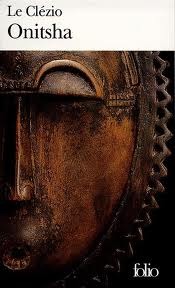 W
WOnitsha is a novel by French Nobel laureate writer J. M. G. Le Clézio. It was originally published in French in 1991 and an English translation was released in 1997.
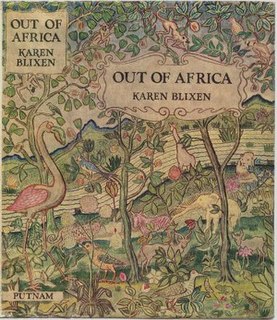 W
WOut of Africa is a memoir by the Danish author Karen Blixen. The book, first published in 1937, recounts events of the seventeen years when Blixen made her home in Kenya, then called British East Africa. The book is a lyric meditation on Blixen's life on her coffee plantation, as well as a tribute to some of the people who touched her life there. It provides a vivid snapshot of African colonial life in the last decades of the British Empire. Blixen wrote the book in English and then rewrote it in Danish. The book has sometimes been published under the author's pen name, Isak Dinesen.
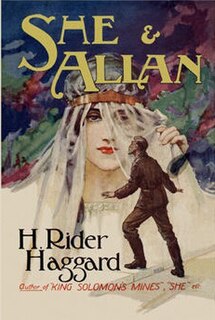 W
WShe and Allan is a novel by H. Rider Haggard, first published in 1921. It brought together his two most popular characters, Ayesha from She, and Allan Quatermain from King Solomon's Mines. Umslopogaas from Nada the Lily also appears in the novel as a major character. Along with the other three novels in the series, She and Allan was adapted into the 1935 film She.
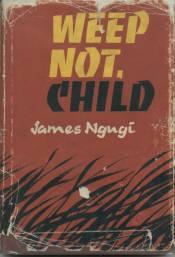 W
WWeep Not, Child is Kenyan author Ngũgĩ wa Thiong'o's first novel, published in 1964 under the name James Ngugi. It was the first English novel to be published by an East African. Thiong'o's works deal with the relationship between Africans and white settlers in colonial Kenya, and are heavily critical of colonial rule. Specifically, Weep Not, Child deals with the Mau Mau Uprising, and "the bewildering dispossession of an entire people from their ancestral land." Ngũgĩ wrote the novel while he was a student at Makerere University.
 W
WWhen Smuts Goes is a dystopian novel by Dr. Arthur Keppel-Jones. The novel is set during a future history of South Africa, following the ascension of Afrikaner nationalists and their increasingly destructive quest for total apartheid. It foreshadowed the fall of Jan Christiaan Smuts and his United Party administration, a rupture in ties with the British Commonwealth, and the declaration of a Second South African Republic. Presiding over the regime which follows is Obadja Bult, a dominion theologian influenced by the ideals of the former Ossewabrandwag. His blunt authoritarian streak gives spark to racial conflict—culminating in foreign intervention and troubled majority rule.